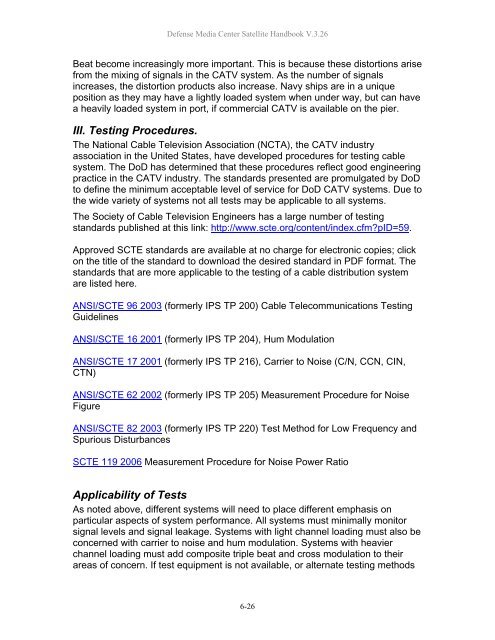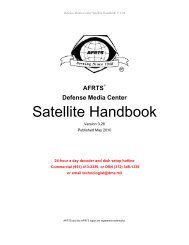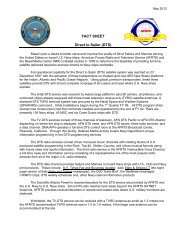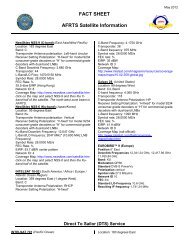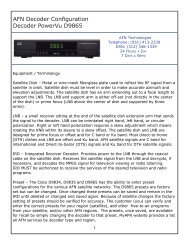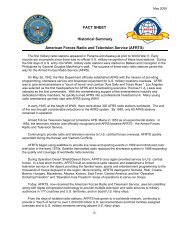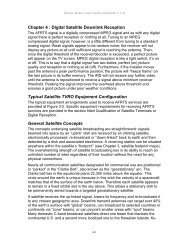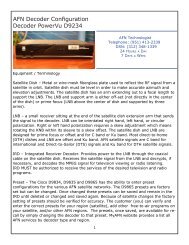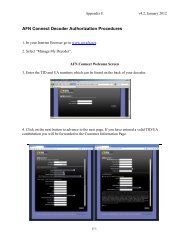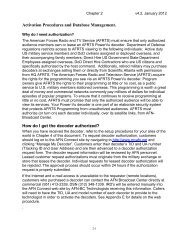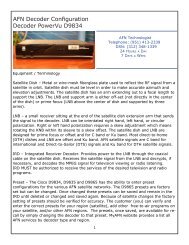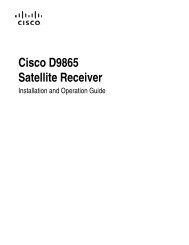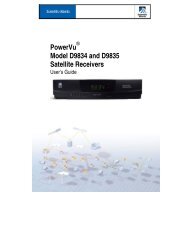AFRTS Defense Media Center Satellite Handbook
AFRTS Defense Media Center Satellite Handbook
AFRTS Defense Media Center Satellite Handbook
Create successful ePaper yourself
Turn your PDF publications into a flip-book with our unique Google optimized e-Paper software.
<strong>Defense</strong> <strong>Media</strong> <strong>Center</strong> <strong>Satellite</strong> <strong>Handbook</strong> V.3.26<br />
Beat become increasingly more important. This is because these distortions arise<br />
from the mixing of signals in the CATV system. As the number of signals<br />
increases, the distortion products also increase. Navy ships are in a unique<br />
position as they may have a lightly loaded system when under way, but can have<br />
a heavily loaded system in port, if commercial CATV is available on the pier.<br />
III. Testing Procedures.<br />
The National Cable Television Association (NCTA), the CATV industry<br />
association in the United States, have developed procedures for testing cable<br />
system. The DoD has determined that these procedures reflect good engineering<br />
practice in the CATV industry. The standards presented are promulgated by DoD<br />
to define the minimum acceptable level of service for DoD CATV systems. Due to<br />
the wide variety of systems not all tests may be applicable to all systems.<br />
The Society of Cable Television Engineers has a large number of testing<br />
standards published at this link: http://www.scte.org/content/index.cfm?pID=59.<br />
Approved SCTE standards are available at no charge for electronic copies; click<br />
on the title of the standard to download the desired standard in PDF format. The<br />
standards that are more applicable to the testing of a cable distribution system<br />
are listed here.<br />
ANSI/SCTE 96 2003 (formerly IPS TP 200) Cable Telecommunications Testing<br />
Guidelines<br />
ANSI/SCTE 16 2001 (formerly IPS TP 204), Hum Modulation<br />
ANSI/SCTE 17 2001 (formerly IPS TP 216), Carrier to Noise (C/N, CCN, CIN,<br />
CTN)<br />
ANSI/SCTE 62 2002 (formerly IPS TP 205) Measurement Procedure for Noise<br />
Figure<br />
ANSI/SCTE 82 2003 (formerly IPS TP 220) Test Method for Low Frequency and<br />
Spurious Disturbances<br />
SCTE 119 2006 Measurement Procedure for Noise Power Ratio<br />
Applicability of Tests<br />
As noted above, different systems will need to place different emphasis on<br />
particular aspects of system performance. All systems must minimally monitor<br />
signal levels and signal leakage. Systems with light channel loading must also be<br />
concerned with carrier to noise and hum modulation. Systems with heavier<br />
channel loading must add composite triple beat and cross modulation to their<br />
areas of concern. If test equipment is not available, or alternate testing methods<br />
6-26


